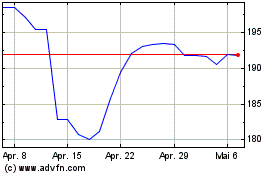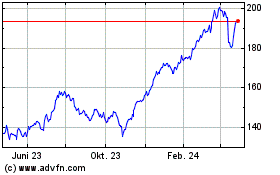New: JPMorganChase Institute Research Shows More Than 90% of U.S. Households Are Able to Cover a $400 Emergency Shock
30 Juli 2024 - 3:00PM
Business Wire
Report Offers Unique, National Data-Driven
Insights into the Share of Americans Living
Paycheck-to-Paycheck
Today, the JPMorganChase Institute released new research
examining Americans’ resilience to unexpected expenses. Leveraging
aggregated data on cash balances, income, spending and credit
access from 5.9 million households, the Institute’s report offers a
more nuanced and comprehensive view of how households can manage
unexpected expenses than survey-based reporting on American
households’ financial health in recent years.
Economic context: There is a growing disconnect between
American households’ perception of their financial health and the
U.S. economy and the data undergirding it. Though the
economy remains healthy by most measures and inflation is well
below its peak, many Americans have a pessimistic view of the
economy, with more than 50% believing that the U.S. is in a
recession. Assessing the economy through a cost-of-living lens can
provide insights into this discussion, especially in light of the
fact that costs for many essential items continue to hover above
pre-pandemic levels.
“Recent economic data has revealed conflicting perspectives
about how Americans are faring financially, and how they view the
health of the U.S. economy,” said Chris Wheat, president of the
JPMorganChase Institute. “Understanding the full picture of
household liquidity is essential to accurately evaluating the
financial resiliency of both consumers and communities.”
A Closer Look at the Data: The report finds that most
households have sufficient liquidity to weather moderate expense
shocks, and that sources of liquidity beyond cash savings are the
key to many households’ ability to weather an emergency expense.
Key report findings include:
- American households are generally financially resilient in
the face of unexpected major expenses. 92% of households are
able to cover a $400 unexpected expense, including 77% of
households in the lowest income quartile.
- Access to credit is crucial for households dealing with
unexpected major expenses. 43% of low-income households that
are unable to weather small unexpected expenses might be able to
pay off such shocks with more available credit.
- Black and Hispanic households are more reliant on disposable
income and credit to cover $400 expenses. Asian and White
households are 10 percentage points more likely than Black and
Hispanic households to be able to cover a $400 expense shock using
just available cash.
Why It Matters: Determining the factors that impact a
household’s ability to pay, and then setting households up with the
proper tools and access, is critical to ensuring Americans can
weather emergency expenses.
The JPMorganChase Institute aims to provide decisionmakers with
timely data and thoughtful analysis to make more informed decisions
that advance prosperity for all. For more insights on the inner
workings of the economy, including on topics related to business
growth and entrepreneurship, careers and skills, community
development and financial health and wealth creation, visit
https://www.jpmorganchase.com/institute.
About JPMorganChase
JPMorganChase (NYSE: JPM) is a leading financial services firm
based in the United States of America (“U.S.”), with operations
worldwide. JPMorganChase had $4.1 trillion in assets and $337
billion in stockholders’ equity as of March 31, 2024. The Firm is a
leader in investment banking, financial services for consumers and
small businesses, commercial banking, financial transaction
processing and asset management. Under the J.P. Morgan and Chase
brands, the Firm serves millions of customers in the U.S., and many
of the world’s most prominent corporate, institutional and
government clients globally. Information about JPMorganChase is
available at www.jpmorganchase.com.
View source
version on businesswire.com: https://www.businesswire.com/news/home/20240730027261/en/
Media contact: Julia Decerega,
julia.decerega@jpmchase.com
JP Morgan Chase (NYSE:JPM)
Historical Stock Chart
Von Dez 2024 bis Jan 2025

JP Morgan Chase (NYSE:JPM)
Historical Stock Chart
Von Jan 2024 bis Jan 2025
